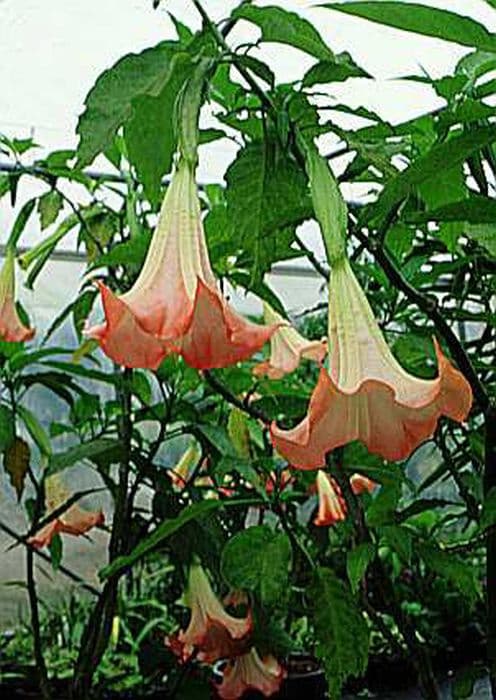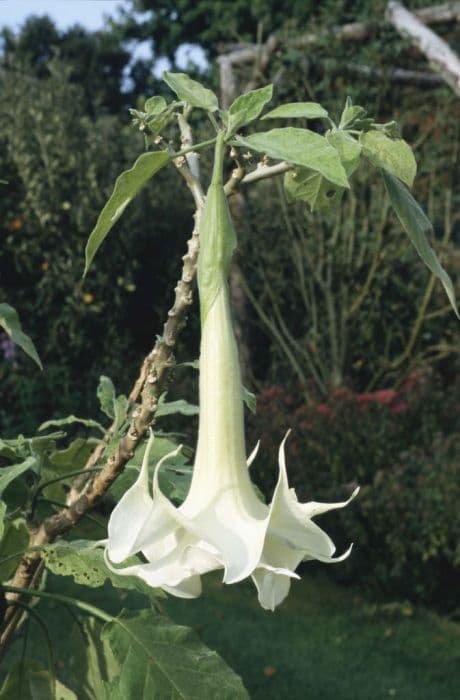Million Bells Calibrachoa Caloha Grand Purple (Caloha Grand Series)
![calibrachoa [Caloha Grand Purple]](/_next/image?url=https%3A%2F%2Fplants-admin.emdemapps.com%2Fimages%2Fplants%2F%2Fimages%2F604b6192993d2.png&w=3840&q=75)
ABOUT
The Calibrachoa Caloha Grand Purple, belonging to the Caloha Grand Series, showcases a stunning display of vibrant purple flowers, which are the standout feature of this plant. These blooms resemble miniature petunias with their funnel-shaped structure and display a strikingly rich purple hue that can add a pop of color to any garden space or container. Each flower is adorned with a delicate, yellow center that contrasts beautifully with the purple petals, enhancing the overall appeal of the plant. The foliage of the Calibrachoa Caloha Grand Purple is equally attractive, comprised of small, green leaves that form a lush and dense backdrop for the colorful flowers. The leaves are slightly sticky to the touch and have fine hairs, giving them a soft texture. The stems are slender and trail gracefully, which makes this plant ideal for hanging baskets or as a spiller component in mixed containers, where it can cascade over the edges to create a full, garden-like effect. The flowering habit of the Calibrachoa Caloha Grand Purple is both prolific and long-lasting, providing a continuous show of color from spring through fall. The plant blooms tirelessly, often covered in a multitude of flowers that create an impressive display. This enduring bloom cycle ensures that gardeners can enjoy the vivid purple flowers for many months throughout the growing season. Overall, the Calibrachoa Caloha Grand Purple is a showy, low-maintenance plant that is known for its ease of care, drought tolerance, and resistance to many common garden pests. With its remarkable flowers and attractive foliage, it is a perfect choice for adding a touch of elegance and charm to outdoor living spaces.
About this plant
 Names
NamesFamily
Solanaceae
Synonyms
Million Bells, Mini Petunia
Common names
Calibrachoa Caloha Grand Purple
 Toxicity
ToxicityTo humans
Calibrachoa is not known to be toxic to humans. While it is generally not considered poisonous, it is not advisable to ingest any part of the plant as it is not intended for consumption. Ingesting plants, even those considered non-toxic, could potentially cause mild stomach upset or an allergic reaction in some individuals. However, there is no well-documented evidence of Calibrachoa causing severe poisoning or death in humans when ingested.
To pets
Calibrachoa is not listed as toxic to pets, such as dogs and cats. However, as with any plant, ingestion of plant material may cause some pets to experience gastrointestinal upset with symptoms such as vomiting or diarrhea, although these symptoms are typically mild and self-limiting. It is always safest to prevent pets from consuming non-food plants as individual animals may have varying sensitivities.
 Characteristics
CharacteristicsLife cycle
Annuals
Foliage type
Evergreen
Color of leaves
Green
Flower color
Purple
Height
0-1 feet (0-30 cm)
Spread
1-2 feet (30-60 cm)
Plant type
Herb
Hardiness zones
9
Native area
South America
Benefits
 General Benefits
General Benefits- Vibrant Color: Produces grand purple blooms that add vividness and aesthetic appeal to gardens and landscapes.
- Continuous Flowering: Offers a long blooming period from spring until frost, ensuring consistent color throughout the seasons.
- Easy to Grow: Known for being low-maintenance and easy to cultivate, suitable for both novice and experienced gardeners.
- Drought Tolerant: Once established, it can withstand periods of low water, making it ideal for drought-prone areas.
- Compact Growth: With its mounding and trailing habit, it's perfect for hanging baskets, containers, and small garden spaces.
- Attracts Pollinators: Invites beneficial insects such as bees and butterflies, promoting biodiversity in the garden.
- Deer Resistant: Less appealing to deer, reducing the likelihood of damage from wildlife.
 Medical Properties
Medical PropertiesThis plant is not used for medical purposes.
 Air-purifying Qualities
Air-purifying QualitiesThis plant is not specifically known for air purifying qualities.
 Other Uses
Other Uses- Photography and Art Projects: The vibrant purple blooms of Calibrachoa can serve as a stunning subject or backdrop for photographers and artists looking to capture the beauty of nature.
- Educational Tools: Educators can utilize Calibrachoa in lessons about plant biology, hybridization, and horticultural practices due to their distinct characteristics and wide range of colors.
- Eco-friendly Confetti: The petals of Calibrachoa can be dried and used as a biodegradable alternative to traditional confetti at celebrations.
- Culinary Decoration: Although not edible, the petals of Calibrachoa can be used to add a splash of color to salads and desserts before serving to enhance presentation.
- Dyes and Pigments: The rich hue of the grand purple variety can potentially be used to create natural dyes for fabrics or pigments for art supplies.
- Fauna Attraction: Planting Calibrachoa can help attract pollinators like bees and butterflies, supporting local ecosystems and biodiversity.
- Themed Gardens: Calibrachoa can be used to create a themed garden space, such as a moonlight or twilight garden, with their deep purple coloration that stands out in the evening light.
- Floating Decorations: Individual blossoms can float in water features or bowls as a decorative element for garden parties or weddings.
- Horticultural Therapy: The care and cultivation of Calibrachoa plants can be incorporated into therapeutic gardening programs for stress relief and mental well-being.
- Miniature Gardens and Fairy Gardens: Due to their small size and abundant flowering, Calibrachoa plants are ideal for creating whimsical miniature and fairy gardens.
Interesting Facts
 Feng Shui
Feng ShuiThe Million Bells is not used in Feng Shui practice.
 Zodiac Sign Compitability
Zodiac Sign CompitabilityThe Million Bells is not used in astrology practice.
 Plant Symbolism
Plant Symbolism- Charm and Beauty: The vibrant purple blossoms of Calibrachoa, commonly known as "Million Bells" due to their numerous, bell-shaped flowers, symbolize enchantment and attractiveness, reflecting the plant's lovely appearance.
- Good Fortune: With its prolific flowering and ease of growth, Million Bells is often associated with bringing good luck and positive energy to one's surroundings.
- Gratitude: Giving Million Bells as a gift can express appreciation and thanks, as their abundant blooms can symbolize the giver's plentiful gratitude.
- Enduring Love: The long-lasting nature of Million Bells flowers throughout the growing season reflects the idea of an ongoing, resilient love.
- Joy and Celebration: The bright and cheerful colors of Million Bells are emblematic of happiness, making them a perfect addition to festive occasions and joyful celebrations.
 Water
WaterMillion Bells, commonly known as Calibrachoa, should be watered regularly to maintain moist but not waterlogged soil. In general, watering once every few days is appropriate, but this can vary depending on temperature and humidity. During hotter seasons or when kept in containers, they may need watering daily. Approximately 8-16 ounces of water per plant should suffice, especially when the top inch of soil feels dry to the touch. It's best to water these plants at the base to avoid wetting the foliage, which can lead to disease.
 Light
LightMillion Bells thrive in full sun, which means they require at least six hours of direct sunlight each day. The ideal spot for these plants would be a south-facing garden bed or a balcony that receives ample sunshine throughout the day. They can tolerate some light shade, especially in regions with very hot summers, but too little light may reduce blooming.
 Temperature
TemperatureMillion Bells prefer warm temperatures and perform best when daytime temperatures are between 55 to 85 degrees Fahrenheit. They can survive minimum temperatures down to 30 degrees Fahrenheit but are not frost-tolerant and should be protected or moved indoors if frost is expected. Ideal growing conditions are met when nights are cool and days are warm, but not excessively hot.
 Pruning
PruningFor Million Bells, pruning is beneficial to promote bushier growth and more blooms. Prune or pinch back the stems every few weeks to encourage branching. The best time for pruning is in the late spring or early summer when plants start to look leggy or after a flush of blooms has finished. Regular deadheading is not necessary as they are self-cleaning, but removing spent blooms and damaged leaves can improve the plant's appearance.
 Cleaning
CleaningAs needed
 Soil
SoilMillion Bells thrive in well-draining and fertile soil with a pH range of 5.6 to 6.0. A good mix would be equal parts peat, potting soil, and perlite or sand to ensure proper drainage and aeration.
 Repotting
RepottingMillion Bells should be repotted annually to refresh the soil and accommodate root growth. It's best to repot in the spring before the onset of the growing season.
 Humidity & Misting
Humidity & MistingMillion Bells prefers moderate humidity levels but can tolerate some variation. Avoid overly humid conditions to prevent disease.
 Suitable locations
Suitable locationsIndoor
Provide bright light and consistent moisture for indoor Million Bells.
Outdoor
Place in full sun to partial shade and protect from strong winds.
Hardiness zone
9-11 USDA
 Life cycle
Life cycleCalibrachoa Caloha Grand Purple, commonly known as Million Bells, begins its life as a seed sown in warm, well-draining soil, usually in early spring. The seed germinates and sprouts into a seedling, which will gradually develop a set of true leaves in addition to the initial cotyledons. As the plant matures, it enters a vegetative stage, growing in foliage and branching out, before starting to produce buds. These buds will blossom into characteristic vibrant purple trumpet-shaped flowers, which are capable of self-pollination, leading to the formation of seeds. After flowering, if conditions are not ideal for seed production or the flowers are deadheaded, the plant may continue to produce new flowers. At the end of the growing season, as temperatures drop, Million Bells will die back if exposed to frost, completing its annual life cycle.
 Propogation
PropogationPropogation time
Spring to early summer
The most popular method of propagating the Calibrachoa, commonly known as Million Bells, is through stem cuttings. This is usually done in the spring or early summer when the plant is actively growing. To propagate, a gardener should take a 4 to 6 inch (10 to 15 cm) cutting from a healthy parent plant, making sure that there are at least two or three sets of leaves on the cutting. The cut end of the stem should then be dipped in rooting hormone to encourage root growth and planted in a soilless potting mix. The cutting should be kept in bright, indirect light and the soil should be kept consistently moist but not soggy. After several weeks, the cutting will develop roots and can be transplanted to a larger pot or directly into the garden.


![Calibrachoa [Aloha Classic Blue Sky]](/_next/image?url=https%3A%2F%2Fplants-admin.emdemapps.com%2Fimages%2Fplants%2F%2Fimages%2F604b636c3778b.png&w=640&q=75)
![Calibrachoa [Aloha Classic Gold]](/_next/image?url=https%3A%2F%2Fplants-admin.emdemapps.com%2Fimages%2Fplants%2F%2Fimages%2F604b6284c573e.png&w=640&q=75)
![Calibrachoa [Aloha Classic Tiki Soft Pink]](/_next/image?url=https%3A%2F%2Fplants-admin.emdemapps.com%2Fimages%2Fplants%2F%2Fimages%2F604b548e0a5ef.png&w=640&q=75)
![Calibrachoa [Cabaret Deep Yellow]](/_next/image?url=https%3A%2F%2Fplants-admin.emdemapps.com%2Fimages%2Fplants%2F%2Fimages%2F604b5f20ca3ef.png&w=640&q=75)
![Calibrachoa [Calibasket Radiant Orange]](/_next/image?url=https%3A%2F%2Fplants-admin.emdemapps.com%2Fimages%2Fplants%2F%2Fimages%2F604b536d43cb2.png&w=640&q=75)
![Calibrachoa [Caloha Classic Blue Velvet]](/_next/image?url=https%3A%2F%2Fplants-admin.emdemapps.com%2Fimages%2Fplants%2F%2Fimages%2F604b604884a75.png&w=640&q=75)
![Calibrachoa [Caloha Classic Honey White]](/_next/image?url=https%3A%2F%2Fplants-admin.emdemapps.com%2Fimages%2Fplants%2F%2Fimages%2F604b5f56e0beb.png&w=640&q=75)
![Calibrachoa [Caloha Classic Yellow Chocolate Ring]](/_next/image?url=https%3A%2F%2Fplants-admin.emdemapps.com%2Fimages%2Fplants%2F%2Fimages%2F604b538aede95.png&w=640&q=75)